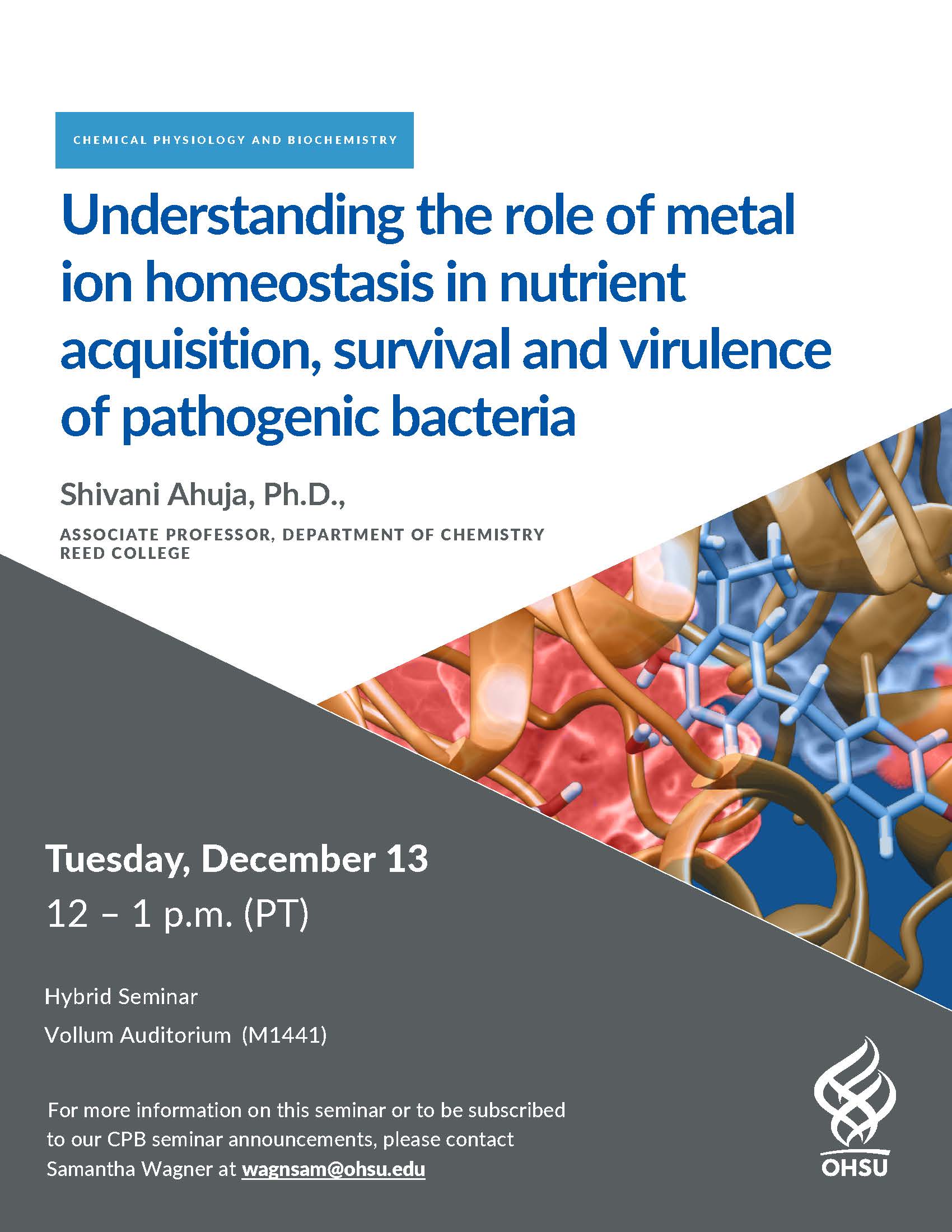Understanding the role of metal ion homeostasis in nutrient acquisition, survival and virulence of pathogenic bacteria, Presented by Shivani Ahuja, Ph.D., Associate Professor, Department of Chemistry, Reed College
| When |
December 13, 2022
12 p.m. to 1 p.m.

Abstract: Pathogenic multidrug resistant bacterial infections are a leading cause of life-threatening human diseases such as pneumonia, tuberculosis, and osteomyelitis. During a bacterial infection, the host employs antimicrobial strategies against the pathogen including bombarding the bacteria with reactive oxygen species (ROS) and sequestration of essential nutrients like metal ions (manganese, iron and zinc). Strains of bacteria have proven remarkably successful at overcoming these and other innate immune strategies employed by the host. Pathogenic bacteria have evolved robust virulence factors including the action of high affinity (nano- to pico- molar) ATP-Binding Cassette (ABC) transporters for Mn(II) and Zn(II), their corresponding efflux transporters and the transcription regulators that work together to successfully confront host sequestration strategies. Despite their importance, the structural basis for their function is poorly understood. Hence, my students and I are using a combination of single-particle cryogenic-electron microscopy (cryo-EM), fluorescence spectroscopy and a variety of biochemical assays to structurally and functionally characterize the synergistic interplay between these different bacterial proteins in regulation of nutrient acquisition, survival and virulence of pathogenic bacteria. Our research is looking at these protein systems in a model gram positive bacterium, Bacillus subtilis, with the intention of expanding the knowledge gained to pathogenic bacteria. The mechanistic insights garnered from such a structurally driven study will not only shed light on the workings of the larger family of such transporters and transcription regulators but will also open new avenues for development of innovative therapeutics to inhibit these deadly pathogens. Samantha Wagner
|
|---|---|
| Where |
Campus:
Building:
3232 SW Research Drive
Portland,
Oregon
97239
Room: M1441 Vollum Auditorium
|
| Contact Information |
Samantha Wagner
|

Abstract:
Pathogenic multidrug resistant bacterial infections are a leading cause of life-threatening human diseases such as pneumonia, tuberculosis, and osteomyelitis. During a bacterial infection, the host employs antimicrobial strategies against the pathogen including bombarding the bacteria with reactive oxygen species (ROS) and sequestration of essential nutrients like metal ions (manganese, iron and zinc). Strains of bacteria have proven remarkably successful at overcoming these and other innate immune strategies employed by the host. Pathogenic bacteria have evolved robust virulence factors including the action of high affinity (nano- to pico- molar) ATP-Binding Cassette (ABC) transporters for Mn(II) and Zn(II), their corresponding efflux transporters and the transcription regulators that work together to successfully confront host sequestration strategies. Despite their importance, the structural basis for their function is poorly understood. Hence, my students and I are using a combination of single-particle cryogenic-electron microscopy (cryo-EM), fluorescence spectroscopy and a variety of biochemical assays to structurally and functionally characterize the synergistic interplay between these different bacterial proteins in regulation of nutrient acquisition, survival and virulence of pathogenic bacteria. Our research is looking at these protein systems in a model gram positive bacterium, Bacillus subtilis, with the intention of expanding the knowledge gained to pathogenic bacteria. The mechanistic insights garnered from such a structurally driven study will not only shed light on the workings of the larger family of such transporters and transcription regulators but will also open new avenues for development of innovative therapeutics to inhibit these deadly pathogens.